The PlayStation 5's new solid state drive isn't your run of the mill PCIe 4.0 SSD. It's heavily customized on a number of levels, including its revamped 12-channel memory controller. While on the surface it has similar specs to a PC-level SSD like PCIe 4.0 interface with 4x lanes on an M.2 card using the NVMe protocol, it's been built from the ground up specifically for the system's custom 7nm AMD SoC and 16GB of GDDR6 system memory. And in many ways, the SSD is the most important part of the PlayStation 5.
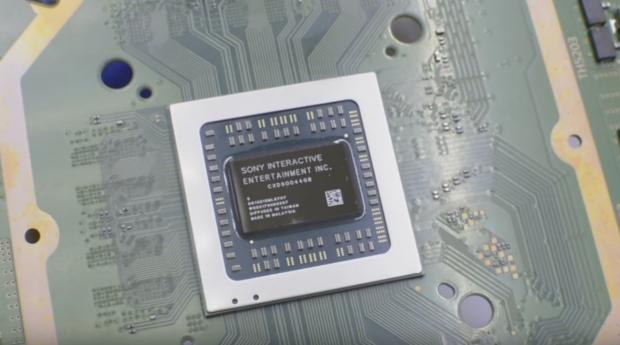
The SSD can deliver uncompressed data to other system components at up to 5.5GB/sec via its new proprietary hardware, which is over twice that of an Xbox Series X. And like the Xbox Series X, the PS5 also has dedicated hardware-based decompression to reduce CPU overhead. The new custom-designed I/O unit is the heart of making all this happen.
In this article we'll be combing through Mark Cerny's latest technical dissection of the PlayStation 5 hardware and putting everything into perspective along the way. This will be a long ride, but if you have even a passing interest in next-gen console storage, it'll be worth checking out.
Let's start with the five main tenants that shaped the PlayStation 5's SSD:
- Boots in a second
- No load screens
- Ultra high-speed streaming
- De-duplicate game data
- No long patch installs
The PS5 architect starts by revealing a startling figure in just how clunky current HDDs are for game design and execution.
"My rule of thumb is that the hard drive is spending 2/3s of its time seeking, and only 1/3 actually loading data. 1GB is roughly 20 seconds to load from a hard drive."
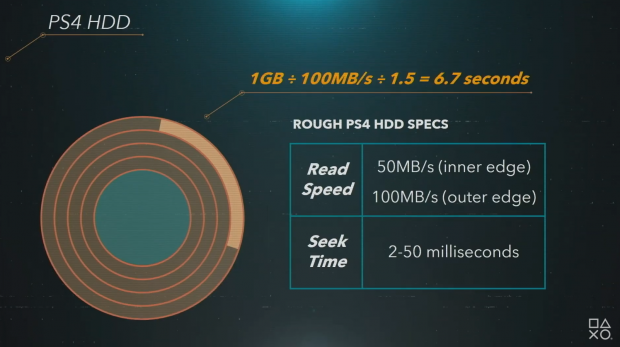
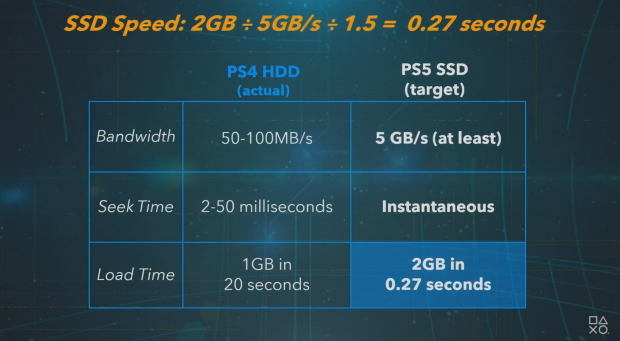
With the PlayStation 5's new custom PCIe 4.0 SSD, Sony can load 5GBs of data in a single second. That's 2GBs in 0.27 seconds. Loading screens are basically eliminated from this raw power.
"We're talking two orders of magnitude faster, meaning very roughly 100 times faster. Which means at 5GB/sec on the SSD that the game boots in a second. There are no load screens. The game just fades down and loads a half-dozen gigabytes, and fades up again. Same for a reload. You immediately get back into the game after you do. And fast-travel becomes so fast that in a blink of an eye you're present."
Loading a game from a hard drive is a different story altogether.
"As a player you wait for the game to boot, wait for the game to load, wait for the level to re-load every time you die, and you wait for what is euphemistically called fast travel."
One of the biggest aspects of the PS5's SSD power is efficiency through speed.
Cerny talks about how devs do creative things to obfuscate and distract gamers from the long load times.
The system's solid state drive significantly reduces the duplication found in today's biggest games. Modern games mitigate read speed limitations by by segregating pieces of a game into data chunks that use tons of duplicated assets and lead to big file sizes. Now with the 5GB/sec throughput for data processing, developers don't have to worry about replicating assets.
"The data can be duplicated so many times that it no longer fits on a Blu-ray disc. You end up with hard limits on the player's run speed or driving speed. The player can't go faster than the load speed on the hard drive."
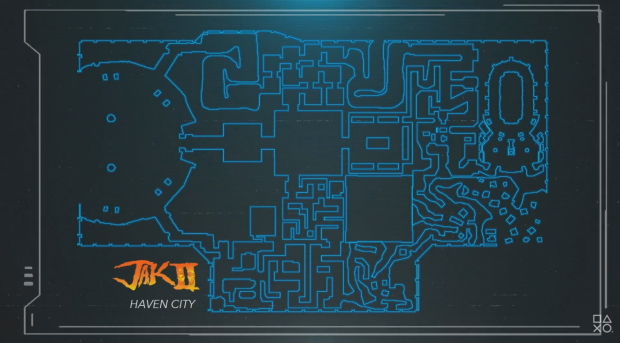
Cerny asserts this will not only change how games are played, but how they're made.
Developers will no longer have to design their games specifically around storage limitations. A lot of the level design in games have specific sequences to optimize data loading. An elevator segment lets the game prepare for the next transition. A winding cave does the same, separate key parts of the world and gives the system an opportunity to load the rest of the next environment.
The system's SSD speeds are so high devs can stream assets directly into the pipeline as they're needed. There's no seeks with an SSD.
"What if the SSD is so fast that as the player is turning around, it's possible to load textures? If it takes half a second to turn, that's 4GB of compressed data you can load."
The result is games that load in less than a second. The PS5's load times are so fast that devs may actually have to artifically slow them down so gamers don't get disoriented, Cerny says.
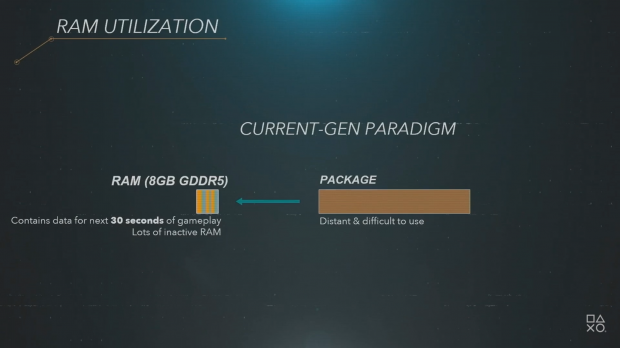

Read Also: PlayStation 5 SSD speeds hit 9GB/sec with custom 12-channel controller
RAM optimizations
Another major benefit is how system memory will be utilized, in particular its data cache.
The PlayStation 5 features 16GB of GDDR6 unified RAM with 448GB/sec memory bandwidth. This memory is synergized with the SSD on an architectural level and drastically boosts RAM efficiency. The memory is no longer "parking" data from an HDD; the SSD can deliver data right to the RAM almost instananeously.
Essentially the SSD significantly reduces latency between data delivery and memory itself. The result sees RAM only holding assets and data for the next 1 second of gameplay. The PS4's 8GB of GDDR5 memory held assets for the next 30 seconds of gameplay.
"There's no need to have loads of data parked in the system memory waiting to potentially be used. The other way of saying that is the most of the RAM is working on the game's behalf."
The SSD allows Sony to keep RAM capacity down and reduce costs.
"The presence of the SSD reduces the need for a massive inter-generational increase in size."
Cerny also confirms the PlayStation 5's SSD improves how patches are installed on the storage. The system no longer needs to create a new file every time a patch is installed. This was previously necessary because the patch would add new seeks, and thus compound the data usage even further.
But as we said above, there's no seeks on the SSD.
"This means no installs as you know them today."
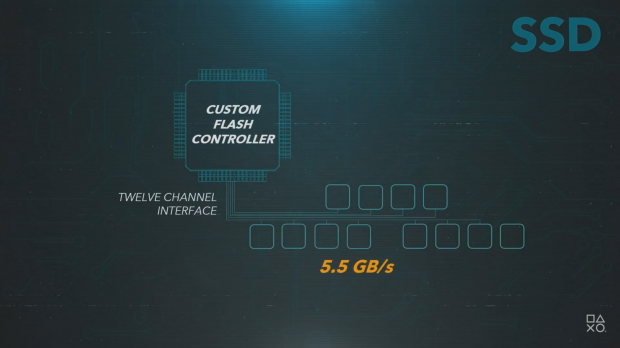
Custom tech
Speed isn't everything though. Sony had to design new software systems on an architectural level to complement the SSD's new capabilities. To get the most out of the new PCIe 4.0 storage, Sony had to reconfigure the base systems that communicate with game code.
"Our goal with the PS5 isn't just that the SSD would be 100x faster. It's that game loads and streaming would be 100x faster as well. So every single potential bottleneck needed to be addressed. And there are a lot of them."
Right now, CPU overhead from data decompression and management is pretty high. The more data that's moved, the more the CPU is taxed, and if it's pushed too far, frame rates drop astronomically. That's a big reason why Sony is optimizing data streaming on the system to ensure pipelines are flowing with enough speed and efficiency so that games look, feel, and run better than ever.
"To solve these issues, we built a lot of custom hardware, namely a custom flash controller and a number of custom units in our main chip."
The flash controller, why may have been designed by Samsung (along with the memory), has 12 channels and offers bandwidth of 5.5GB/second. Six of them are prioritized for gaming.
Cerny says the 12 channel interface was the main reason Sony chose the odd 825GB storage capacity for the PlayStation 5.
The architect strongly hints that PS5 game installs will be massively reduced, unlike the huge 100GB leviathans we have today. So 825GB on the SSD should stretch farther than 1TB on today's normal HDD.
"The question remains: Is this enough? It's tempting to add more, but flash certainly doesn't come cheap and we have a responsibility to our gaming audience to be cost effective with regards to what we put in the console."
To figure out if more storage was needed, Sony surveyed what kinds of games PS owners were playing and whether or not they'd fit on the SSD.
"We were able to establish the friction cost by re-installs and re-downloads would be quite low. And so we locked in on that 825GB size."
Four lanes of the custom 12 channel memory controller connect directly to the PCIe 4.0, meaning we're getting x4 performance (Anyone who's read up on PCIe 4.0 will have seen mention of x4 lanes and the improvement boosts this spec offers).
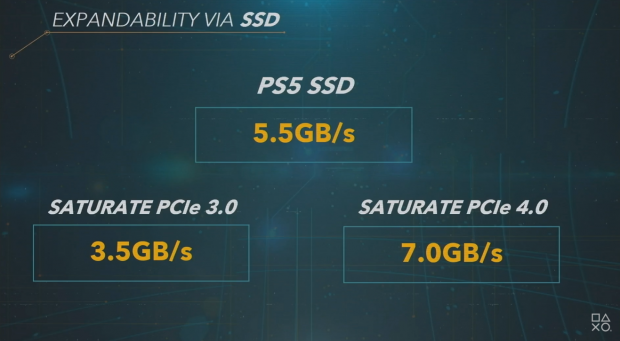
Storage Expansion
But what about expandable storage? HDDs are still supported, but gamers need a way to expand the higher-end SSD performance to ensure they can keep playing PS5 games. Pretty much every game is getting bigger and bigger now, and even with compression techniques and massive efficiently toolsets, 825GB won't be enough indefinitely.
Sony solves this by allowing select PC M.2 SSDs to swap into the console. Sony won't roll out proprietary memory card storage for the PS5, unlike Microsoft.
Gamers can buy an appropriately-specced PC SSD off the shelves and plug it right into their PlayStation 5 to expand the memory. There's a few catches, though: The SSD needs to be at least as fast as the PS5's internal drive, and it needs to be approved by Sony first to ensure compatibility.
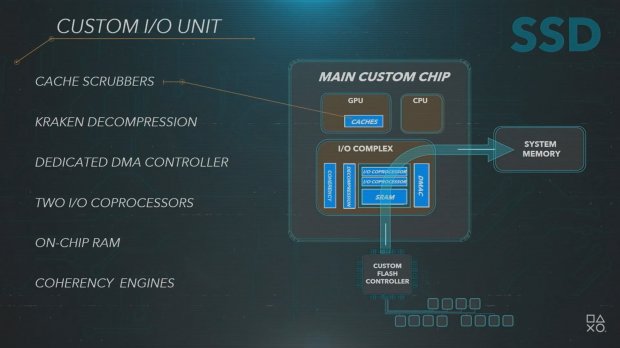
Hardware-based compression
Compression is a huge part of the PlayStation 5's data management. The console will have a powerful new compression system that essentially shrinks data and reduces the overall install size of data on your SSD. So not only will games have less redundant assets, they can be smaller, too.
Like the Xbox Series X, the PlayStation 5 will have its own hardware-based compression block that's situated on the 7nm SoC.
Basically this means a section on the console's main chip will be dedicated to decompressing data. This will help the CPU in decompressing the compressed data from downloads, installs, and discs.
Decompression is very taxing on a CPU and causes lots of overhead, so this will free up the CPU to other in-game tasks like higher frame rates.
The PS5 uses a derivative of RAD Tool's potent Kraken decompression technology, which offers 10% better compression--that's about 10% more installations or data on a Blu-ray disc. Without the dedicated decompressor, it would take 9 Zen 2 CPU cores to decompress Kraken-level data.
The SoC also has a DMA (direct memory access) controller that allows devs to designate where data goes to the SSD. It's a means of further reducing data-streaming bottlenecks.
The I/O complex further houses two co-processors that help direct that data traffic. One co-processor is focused on SSD input-output that's specifically designed to bypass file read bottlenecks. The other handles memory mapping. The SRAM, or static RAM, which grants faster access to cached memory.
Finally there's a block dedicated to coherency engines which work directly with the GPU to optimize caching. The engines communicate with the GPU, which "scrubbers" that clean up cached data on the GPU itself to improve efficiency and ensure the cache isn't filled with redundant data.
Summary
There's still a lot we don't know about the PlayStation 5's SSD, like what time of flash memory it uses (likely QLC), who built it (likely Samsung), and all of the other architectural components that help tie the hardware together on a software level.
But Cerny's deep dive gives a great look at what to expect from the PlayStation 5's storage technology in the future...and just like the Xbox Series X, the PS5's SSD will transform console gaming as we know it. Developers will be armed to the teeth to defeat bottlenecks and create expansive, wide, and vastly immersive open worlds the likes of which we've never seen before.
Hopefully soon we'll actually see some PS5 gameplay and the system in action. But for now, I think Sony dished out quite a bit of info.
The console will release in Holiday 2020, and it may cost $499.
Check below for more info on everything we know about the PlayStation 5 so far:
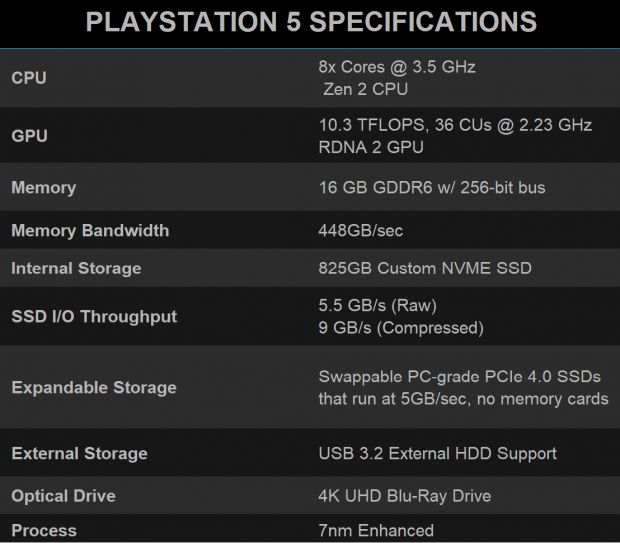
PlayStation 5 specs and details:
- Custom SoC with second-gen Navi GPU, Zen 2 CPU
- 8-Core, 16-thread Zen 2 CPU at 3.5GHz
- Navi GPU with 36 CUs on RDNA 2, 2.23GHz
- Navi, Zen SoC uses new AMD RDNA 2.0 architecture
- Ultra-fast 825GB SSD with up to 9GB/sec speeds
- Support for 4K 120 Hz TVs
- Ray-tracing enabled
- 8K output support (for gaming)
- Plays PS4 games, BC is on a title-to-title basis
- Separate games that ship on BD-XL Blu-ray discs
- New controller with extensive haptic and tactile feedback
PlayStation 5 Coverage:
- PlayStation 5 specs confirmed by Sony: 10TFLOPs Navi RDNA 2 2.23GHz GPU, 3.5GH Zen 2 CPU
- PlayStation 5 could use Samsung's 980 QVO SSDs
- PlayStation 5 is beating Xbox Series X in dev kit form right now
- Hardly any devs are making next-gen PS5, Xbox Series X games
- Sony working on new horror IP for PlayStation 5
- PlayStation 5 devkit UI possibly leaked
- Leaked PlayStation 5 concepts show weird X-shaped case
- Sony's first-party PS4 exclusives are coming to PC
- PlayStation 5's new DualShock 5 may be usable on PS4
- Sony skips E3 2020, has two major events planned for February
- Next-gen console exclusives will be few and far between through 2021
- PlayStation 5's biggest features have yet to be announced, Sony says
- PS4 has sold over 1 billion games and 106 million consoles
- PlayStation 5 backward compatibility should support every PS4 game
- Sony reveals the PlayStation 5...logo
- New trapezoidal PS5 render is an expensive accident waiting to happen
- A $399 PlayStation 5 will conquer next-gen
- PlayStation 5 to outsell Xbox Series X in 2020, analyst predicts
- PS5 may only enhance PS4 games, legacy PS1, PS2 and PS3 games unlikely
- PlayStation 5 prototype dev kit console gets V-shaped clean
- Sony: The future is coming at CES 2020
- PlayStation 5 GPU: 9.2 TFLOPs with 36 custom Navi compute units
- PlayStation 5 GPU emulates PS4, PS4 Pro with special modes
- PS5, Xbox Series X SSD may use software-defined flash to boost speeds
- PS5's SSD is 'exceptionally powerful,' may beat Xbox Series X speeds
- DualShock 5 renders show new trigger design, USB-C, ergonomic shell
- PlayStation 5 to support 8K gaming, Sony confirms
- New PlayStation 5 renders show off radical different design, again
- Leaked PlayStation 5 ad prices console at $1,000, is totally fake
- Sony seeks a new Head of Strategy for Worldwide Studios
- Leaked PlayStation 5 devkit photos show new DualShock controller
- PS5, Xbox Scarlett SSD may use Optane-like ReRAM to supercharge speeds
- NVIDIA G-Sync monitors to improve PlayStation 5 and Xbox Scarlett
- PlayStation 5: Everything We Know So Far
- PlayStation 5 confirmed to have 8C/16T Zen 2 CPU from AMD
- PS5, Project Scarlett may use Samsung's 6th gen V-NAND NVMe SSDs
- PS5 backward compatibility confirmed, will play PS4 games
- Sony's next-gen PlayStation 5 has 4K 120Hz output support
- PS5, Project Scarlett to hit over 10TFLOPs of power, sources say
- PS4 will be supported into 2022, to live alongside PS5
- Sony: ultra-high-speed SSD is 'the key' to next-gen PS5
- PS5 dev kit rumor: 'ultra-fast RAM', Navi GPU with 13 TFLOPs
- PlayStation 5 rumored to ship with 2TB of super-fast SSD for $499
- Insider: PlayStation 5 dev kit faster than Xbox Scarlett right now
- PS5 cartridges aren't real, patents are for Sony kids toys
- PS5's SSD may benefit PS4 games the most
- PS5 powered by Navi in 2020, AMD making Navi with Sony input
- Cloud-powered PlayStation controller may let you play free game demos
- Gran Turismo 7 is a PlayStation 5 launch title: launches Nov 20, 2020
- PS5 confirmed to support 8K video, ray tracing, all on Navi
- PlayStation 5 rumored to cost $499, launches November 20, 2020
- PlayStation game demos are coming back with Sony's ambitious new plan
- PS5 controller: Built-in mic, USB-C, no lightbar, ergonomic design
- PlayStation 5 concept video shows totally new design
- Sony solves PS5's biggest issue
- Sony: PS5 development going according to plan
- New Viking Assassin's Creed may be next-gen console launch game
- AMD working on 'secret sauce' for next-gen Xbox/PlayStation
- The first real photo of a PlayStation 5 dev kit appears
- Next-gen PS5/Xbox Scarlett open-world game: 'best real-time graphics'
- Sony restructures workforce to prepare for PS5
- PlayStation VR 2: built-in cameras, wireless, ready for PS5
- PS5 games will ship on 100GB Blu-ray BDXL discs
- PS5 and Xbox Scarlett will both handle ray tracing differently
- PlayStation 5 could feature AI-powered 'PlayStation Assist'
- Sony won't abandon singleplayer story-driven games on PS5
- PS5 rumor: GPU is nearly as powerful as RTX 2080, GPU clocked at 2GHz
- PlayStation 5 rumored to be unveiled on February 12, 2020
- Sony to raise PS5 cost thanks to U.S. tariffs


